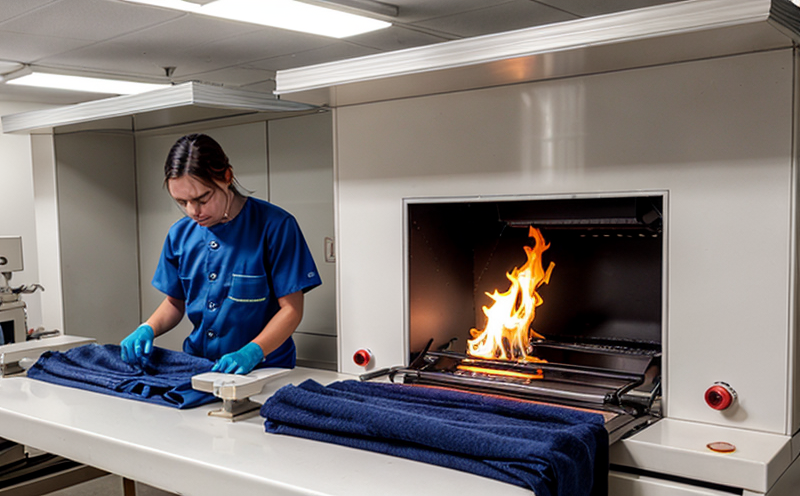Assessment of Heat Release Rate in Apparel Fabrics
The heat release rate (HRR) is a critical parameter in assessing the flammability and fire safety properties of textiles, particularly within apparel fabrics. Understanding HRR involves measuring how quickly a fabric releases heat during combustion. This assessment plays an essential role in ensuring compliance with international standards such as ISO 5637-2:2018, ASTM E648-19, and EN 13569:2015.
The HRR test is often part of a broader set of fire safety tests that include smoke production, heat release duration, and other related measures. These tests are vital for ensuring that textiles meet the stringent requirements imposed by regulatory bodies to protect consumers from the risk of fire-related accidents. For instance, in the fashion industry, fabric suppliers must guarantee their products pass rigorous testing to ensure they do not pose a hazard when worn or used.
The process typically involves subjecting a sample of the fabric to controlled combustion under specific conditions. The apparatus used for this test can vary but commonly includes calorimeters capable of measuring the heat release rate over time as well as sensors that capture other relevant data points like oxygen consumption and carbon dioxide production. Specimen preparation is crucial; it often involves cutting precise samples from garments or simulating real-world wear patterns to mimic actual conditions during combustion.
Once tested, the results provide valuable insights into how quickly the material might ignite and spread heat once exposed to a flame source. This information helps manufacturers make informed decisions about fabric selection and design changes aimed at enhancing product safety without compromising on style or comfort. By understanding these parameters early in development cycles, companies can better predict potential issues during production and address them proactively.
For quality managers and compliance officers responsible for ensuring products meet required standards, this service offers an indispensable tool for maintaining high levels of fire safety across all product lines. Additionally, research & development engineers benefit from detailed HRR data when innovating new materials or refining existing ones to achieve desired performance characteristics. Procurement teams also find value in knowing which suppliers provide fabrics that consistently pass stringent testing requirements.
The importance of accurate and reliable HRR assessments cannot be overstated given the increasing emphasis on public safety and environmental responsibility within industries like fashion, home textiles, and furniture manufacturing. As consumer demand for safer products continues to grow, so too does the need for precise measurement techniques like those provided by our laboratory services.
Scope and Methodology
| Aspect | Description |
|---|---|
| Test Specimen Preparation | Samples are cut to standard sizes according to ISO 5637-1:2018, ensuring uniformity across all tests. |
| Combustion Conditions | The specimen is exposed to a controlled flame for a specified duration, typically 2 seconds, in accordance with ASTM E648-19. |
| Data Collection | Measurements of heat release rate are captured using high-precision calorimeters, along with associated variables such as oxygen consumption and carbon dioxide production. |
The scope of our HRR testing extends beyond simple measurement to include comprehensive analysis that provides actionable insights. Our team of experts ensures every step adheres strictly to relevant international standards, guaranteeing accuracy and consistency in results.
Our methodology emphasizes precision and repeatability, making it ideal for research and development purposes where iterative improvements are necessary. By providing consistent, reproducible data, we enable clients to make informed decisions about material choices and process optimization.
Benefits
The ability to accurately assess heat release rates offers numerous advantages for businesses operating in the textile and apparel sectors. Here are some key benefits:
- Enhanced Product Safety: Ensures that products comply with international fire safety standards, thereby protecting consumers from potential hazards.
- Informed Decision Making: Provides valuable data to support R&D efforts in developing safer fabrics and improving existing ones.
- Regulatory Compliance: Helps manufacturers avoid costly recalls and penalties associated with non-compliance issues.
- Customer Confidence: Builds trust among customers who prioritize safety when purchasing clothing items or furnishings.
In addition to these tangible benefits, the service also contributes to broader environmental sustainability goals by encouraging responsible material selection that reduces waste generation and promotes circular economy practices.
Use Cases and Application Examples
| Use Case/Example | Description |
|---|---|
| Fashion Industry | Ensuring that new fabric designs meet stringent flammability requirements before going to market. |
| Home Textiles | Testing upholstered furniture for flammability in accordance with local regulations. |
| PPE Manufacturers | Verifying the flame resistance of personal protective equipment worn by workers in hazardous environments. |
Our HRR testing service has broad applicability across various industries, each presenting unique challenges and opportunities for innovation. By leveraging this capability, organizations can stay ahead of regulatory trends while enhancing their competitive positioning through safer product offerings.
In the fashion industry, for example, designers are continually seeking ways to balance aesthetics with practicality without compromising on safety standards. Our HRR tests help them achieve just that by identifying optimal fabric combinations and construction techniques that minimize risk during use.





